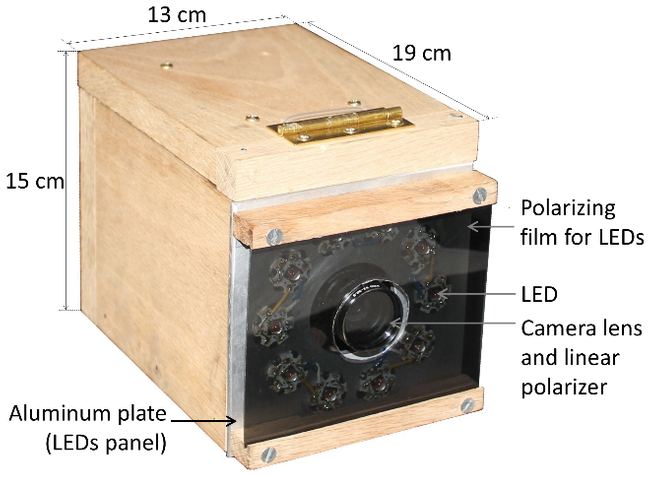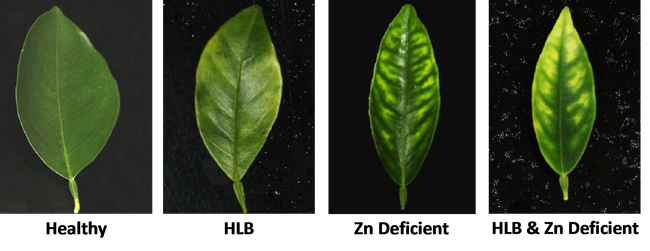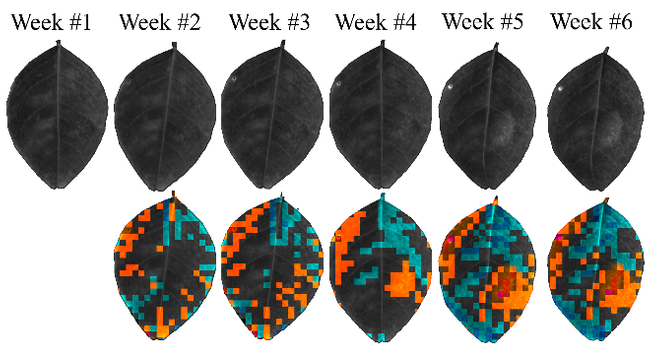Kearney Research and Extension Center, University of California Cooperative Extension
California is the major producer of fresh market citrus in the U.S., a $2 billion industry that is threatened by a devastating disease called citrus Huanglongbing (HLB). Unfortunately, there is no cure for this disease and if a tree gets infected, it will die in a few years. In Florida, HLB was first seen in 2005, but after a few years the entire state of Florida got infected. Today, about 60% of Florida citrus has gone, mostly because there was no efficient HLB monitoring practice. HLB diagnosis using laboratory-based methods required manual sampling and they were time and effort consuming. An efficient HLB management requires high spatial and temporal resolution monitoring and eradication of infected trees. Therefore, a diagnosis sensor is needed for detecting HLB infected canopies before the development of symptoms. For high resolution monitoring, the sensor should also be able to conduct rapid and inexpensive inspection with high accuracy.
Starch accumulation in HLB infected leaves is an early indication of the disease. Starch has an optical characteristic of rotating the polarization plane of light. We employed this characteristic of starch to develop an early detection methodology in which the sensing system was very sensitive to the rotation in polarization plane of light. The sensor has a customized illumination system including 10 high-power and narrow band LEDs at 591 nm and a polarizing film. The sensor also has a monochrome camera equipped with a linear polarizing filter that is set in a perpendicular direction to the polarizing film of the illumination system.
Starch accumulation in an HLB infected leaf generates blotchy mottle in an asymmetrical yellowing pattern. Deficiency of certain nutrients such as Mg and Zn causes symptoms similar to HLB.
The sensor was mounted on a gator vehicle and was tested in a citrus grove in Florida. The polarized images acquired from healthy, HLB, and Zn deficient canopies were further analyzed for diagnosis purpose.
HLB samples were accurately identified from healthy and Zn deficient samples. Also, the sensor was able to detect HLB within Zn deficient samples.
The polarized imaging methodology was adopted in two separate studies at the University of Florida to investigate the earliest time HLB can be diagnosed by polarized imaging technique after infection. In one study, two-year old Valencia orange plants were inoculated using disk-graft method.
Time-lapse polarized images of leaves from inoculated citrus plants were acquired on a weekly basis. HLB symptoms (as starch accumulation) started to become visible in the polarized images five weeks after inoculation, while the plants were still in asymptomatic stage.
In another study, the polarized imaging methodology was employed to detect HLB in insect inoculated citrus seedlings while in asymptomatic stage. Citrus seedlings were exposed to intensive HLB-positive Asian Citrus Psyllid (ACP) feeding. Polarized images were acquired two times; once after one month after inoculation and again two months after inoculation. As well as HLB detection, the level of infection was obtained for different leaf samples. Polymerase chain reaction (PCR) tests were conducted to validate the HLB status and the level of infection in each leaf sample.
Currently, we focus on improving the accuracy and early detection performance of the polarized imaging sensor and developing a commercialized product for practical in-field diagnosis. This affordable tool can help the California citrus growers to protect their groves from HLB.
Photos, from top to bottom:
Sensor Prototype
Leaf Symptoms of HLB and Zn Deficiency
Time Lapse Images of HLB Infected Leaves Over Time
Attached Images:


